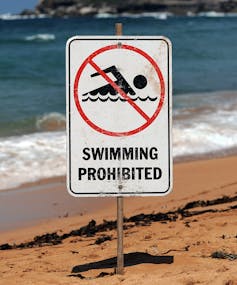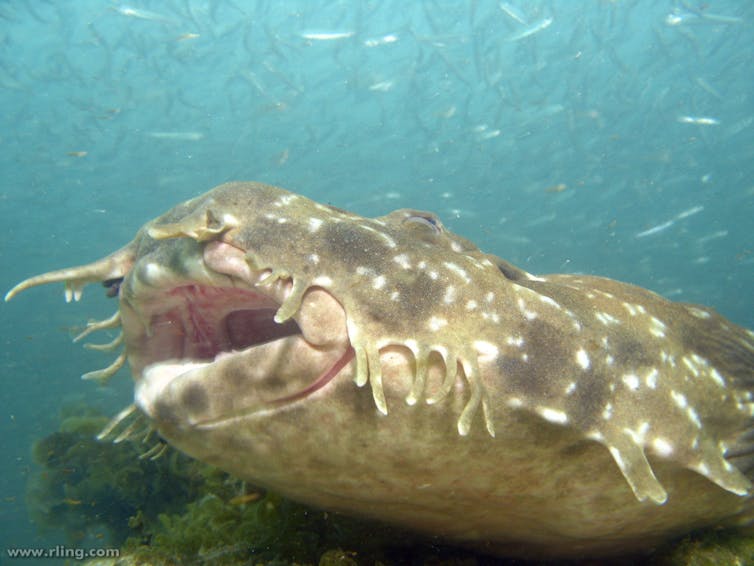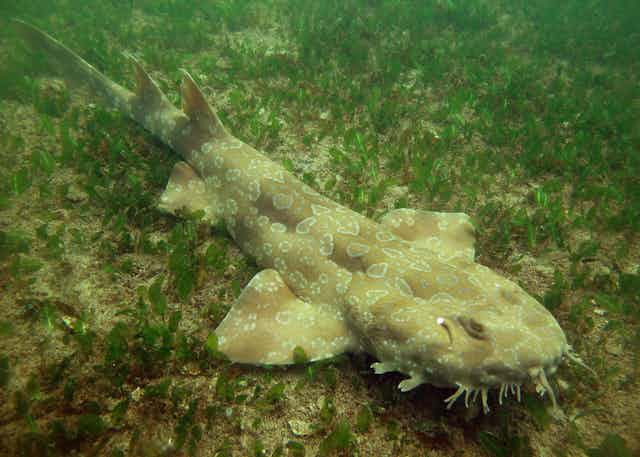We’ve known since early last year that sharks are most likely colour-blind. But today, in a paper published in Biology Letters by our team at UWA, we explain why this is the case.
It’s a finding we believe could help prevent shark attacks and other negative encounters between these marine predators and humans in the future.
With the recent spate of shark attacks off the coast of Western Australia, the question of how to coexist peacefully with these fascinating and complex animals is at the forefront of the debate in the community, the media and local government.
It is with this in mind that our lab investigates the sensory systems of sharks and their relatives. If we can understand how these animals sense the world around them, we can begin to predict how they will respond under certain circumstances, and ultimately manipulate their behaviour.

In the aftermath of a fatal shark attack – such as the one that claimed the life of a 24-year-old Perth surfer in July – there are often calls for either targeted or widespread culling of sharks, and this sentiment is of course understandable in the face of such tragedy.
But – and not least because these attacks occur when people have ventured into the shark’s habitat – many believe that a better understanding of shark behaviour, and the development of non-invasive shark deterrents, are more responsible and sustainable solutions.
Keeping an eye on things
Over the past few years, we have studied the visual systems of many different species of elasmobranch (sharks and rays) and what we have found is a diversity in eye design that mirrors the ecological and behavioural diversity of the taxon (a population of organisms).
Sharks were traditionally thought to have very poor vision, a theory based largely on the nocturnal habitats of the limited number of representative species used for the original studies.
But research over the past 20-30 years has shown this is not the case: sharks are highly visual animals that use well-developed eyes to find prey and mates, avoid predators and navigate.
They do, however, have one interesting feature – as mentioned before, they are probably totally colour blind.
Rods and cones
Vision depends on light-sensitive photoreceptor cells located in the retina. Thee are two different types of photoreceptor cell: rods and cones.
Rods are exquisitely sensitive and usually operate in very dim light. Generally, there is only one spectral “type” of rod and so they are not used for colour vision.
Cones, on the other hand, operate best in bright light and are what humans and other animals use for discerning fine detail and for colour vision.

Colour vision is possible when there are different spectral types of cone – each of which contains a photopigment sensitive to different part of the visible spectrum – and the nervous system can compare the signals from these different cone types.
Previous work in our laboratory has shown that sharks only have a single spectral type of cone photoreceptor in the retina and, therefore, are probably completely colour blind.
What we’ve done
Our new study, in Biology Letters, reveals the molecular basis for this cone monochromacy in two species of wobbegong (“carpet”) shark.
In addition to a gene that codes for the green-sensitive rod photopigment, there is only one cone photopigment gene that generates a red-sensitive cone pigment.
There is a possibility that sharks may compare the signals from rods and cones at intermediate light levels (when both rods and cones are functional) to generate a rudimentary form of colour vision, but limited behavioural evidence suggests this does not occur.

Interestingly, the situation in sharks reflects that of another group of large aquatic animals comprising the whales, dolphins and seals, which are also cone monochromats and share the same complement of rod and cone visual pigment genes as the sharks.
Although we cannot yet rule out the possibility some sort of evolutionary bottleneck – such as an extended period of nocturnality – led to the loss of all but one cone photopigment gene in sharks and marine mammals, this similarity in retinal design between taxa (the plural of “taxon”) separated by millions of years of evolution suggests it may be a nice example of convergent evolution (unrelated organisms evolving similar traits) in visual system design.
Which leaves us with an important question: why is colour not important to these large marine predators? We do know that many species of stingray have colour vision, as do most of the bony fish.

In fact, most vertebrates, aquatic or terrestrial, have some form of colour vision based on two or more cone types in the retina.
While this and other questions are the subject of ongoing research, one other outcome of the new study and the work in general is that we now have a much better understanding of how sharks sense the world around them.
This is increasingly important in a world where the most frequent outcomes of interactions between sharks and humans are negative ones.
Peace, love and understanding
Tens of thousands of sharks are killed unnecessarily each year as bycatch in long-line fisheries that are targeting other species of fish.
A deeper understanding of the visual system and other senses of sharks will allow us to design long-line fishing lures that are less attractive to sharks and, hopefully, reduce this bycatch.
Similarly, it may be possible to design equipment such as wetsuits and surfboards that passively reduce the risk of shark attack or sensory-based deterrent devices, along the lines of the Shark Shield, which produce unpleasant but non-fatal stimuli to actively repel sharks from individuals or whole beaches.
It is our sincere hope that our research leads to a greater understanding of the biology and behaviour of these iconic megafauna and that this will result in better outcomes for both sharks and humans when their paths cross.

